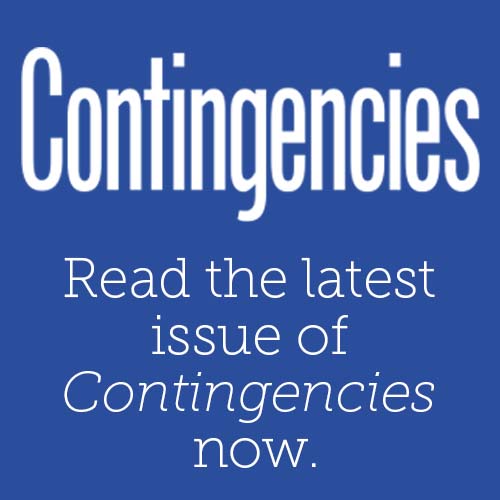Part of a Complete Breakfast
By Tom Wildsmith
President, American Academy of Actuaries
The following appeared in the July issue of Actuarial Update. I loved watching Saturday morning cartoons when I was a kid. The commercials were almost as entertaining as the shows. As I remember it, the typical Saturday morning advertisement was for breakfast cereal. It was a golden era for children’s cereals. While the sensible cereals of the early 20th century were still available, manufacturers had discovered that they could include startling colors, flavors unknown to nature, and—my personal favorite—marshmallows.
I loved watching Saturday morning cartoons when I was a kid. The commercials were almost as entertaining as the shows. As I remember it, the typical Saturday morning advertisement was for breakfast cereal. It was a golden era for children’s cereals. While the sensible cereals of the early 20th century were still available, manufacturers had discovered that they could include startling colors, flavors unknown to nature, and—my personal favorite—marshmallows.
They were great fun, and always made me feel like I was getting away with something. How else could you get to eat marshmallows for breakfast? Every cereal had its own cartoon mascot, and the ads focused on what appealed most to children—the colors, the flavors, and the marshmallows.
But all of the ads had a strange little twist at the end. They would cut to a small bowl of cereal that was surrounded by other things—a glass of milk, a glass of juice, a slice of toast with jam, an egg, perhaps grapefruit, a couple of slices of bacon, or even a cup of coffee. The details varied, but it was always a surprising amount and variety of food. Then the announcer would say, “…part of a complete breakfast!” Even as a kid, I sometimes wondered why you would want cereal if you could have fresh eggs, bacon, and toast.
I suspect that cereal companies included this disclaimer for legal reasons. But there was an important message in it for parents. The point of breakfast isn’t cereal, or even marshmallows—it’s nutrition. We feed our children breakfast to ensure they get the nutrition they need— and that takes more than just cereal.
Continuing education (CE) is a bit like cereal—the point isn’t simply to rack up hours, but to ensure that we, as actuaries, are competent at what we do. CE is neither an end in itself, nor all that we need. CE doesn’t exist in a vacuum; just as cereal is only one part of a complete breakfast, our CE requirements are only one element in ensuring the competence of actuaries.
What else do I need to be a competent and responsible working actuary? A basic actuarial education is necessary to ensure that I’m familiar with the fundamental tools and techniques that are relevant to my practice area. Work experience, to ensure that I have a reasonable level of practical competence. I must also be familiar with the laws, regulations, and standards of practice that apply in my specific area of practice. These aren’t arbitrary requirements; they are common-sense necessities. They are also the essential elements covered by the Qualification Standards for Actuaries Issuing Statements of Actuarial Opinion in the United States (the U.S. Qualification Standards, or USQS). The goal of these standards is to ensure that actuaries practicing in the United States are fully competent to perform the specific work that they are actually engaged in.
Continuing education can’t replace basic actuarial education or work experience, but it does play a vital role in supplementing them. Our CE requirements are intended to ensure that a practicing actuary’s knowledge remains current and relevant. Understanding the purpose and context for continuing education can help us make wise choices. Have important new tools and techniques been introduced since I completed my exams? Are there aspects of my practice area where my personal experience is weak? Have there been changes in the laws, regulations, or standards of practice that are relevant to my work? By recognizing the realworld rationale behind the qualification standards and making judicious use of continuing education to fill any emerging gaps in our knowledge or experience, we can maintain our ability to provide high-quality actuarial services in a rapidly changing world.
There is some value in making cereal flavorful and fun—it encourages children to eat. CE can be delivered in a variety of ways. Different approaches may work better for different people, and just as with cereal, new “flavors” of CE are continually being developed. But whether I attend a webinar or complete an online training module, the goal is the same—to ensure my continued competence. The Code of Professional Conduct requires that we do actuarial work only when we’re qualified to do so on the basis of “basic education and continuing education and experience” and only when we meet applicable qualification standards.
Almost everyone needs breakfast, and the same is true of continuing education. The U.S. Qualification Standards recognize that “qualification” isn’t a free-floating concept—I am qualified (or not qualified) with respect to a specific set of actuarial services or area of practice. Because the goal of the standards is to ensure that the public can rely on the work done by actuaries, the standards are written to focus on the final results that we present. The technical term “Statement of Actuarial Opinion” (SAO) is used for this; some might misunderstand this term to be limited to a formal statement filed with a regulator—nothing could be further from the truth. A simple rule of thumb is that if I perform work that someone else relies on because I am an actuary, then the qualifications standards likely apply—because for them to rely on my work, I have to communicate the results (give an opinion) in some fashion. Some of us have retired, or are no longer working as actuaries— but for the rest of us, staying current is a necessity. (For additional information on this subject, see my piece in the September-October issue of Contingencies magazine.)
I still eat cereal, but it’s no longer all about the marshmallows— I have a more mature appreciation for the importance of nutrition. Continuing education is a part of my life, and I track my hours— but I no longer think of it as a matter of accumulating an arbitrary number of hours. Over the years I’ve developed a more mature appreciation for the need to maintain my professional competence. CE—it’s part of a complete framework for ensuring professional competence.







